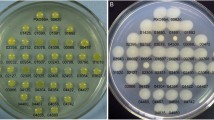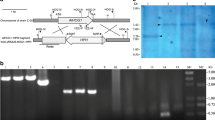Abstract
A two-component signal transduction system is a common mechanism for environmental sensing in bacteria. The functions of the two-component molecules have been also well characterized in the lower eukaryotic fungi in recent years. In Saccharomyces cerevisiae, the histidine kinase Sln1p is a major component of the two-component signaling pathways and a key regulator of the osmolarity response. To determine the function of MoSLN1, a Sln1 homolog of Magnaporthe oryzae, we cloned the MoSLN1 gene and generated specific mutants using gene knock-out strategy. Disruption of MoSLN1 resulted in hypersensitivity to various stresses, reduced sensitivity to cell wall perturbing agent Calcofluor white, and loss of pathogenicity, mainly due to a penetration defect. Additionally, we showed that MoSLN1 is involved in oxidative signaling through modulation of intra- and extracellular peroxidase activities. These results indicate that MoSLN1 functions as a pathogenicity factor that plays a role in responses to osmotic stress, the cell wall integrity, and the activity of peroxidases.






Similar content being viewed by others
References
Aguirre J, Ríos-Momberg M, Hewitt D, Hansberg W (2005) Reactive oxygen species and development in microbial eukaryotes. Trends Microbiol 13:111–118
Alex LA, Borkovich KA, Simon MI (1996) Hyphal development in Neurospora crassa: involvement of a two-component histidine kinase. Proc Natl Acad Sci USA 93:3416–3421
Alonso-Monge R, Navarro-Garcia F, Román E, Negredo AI, Eisman B, Nombela C, Pla J (2003) The Hog1 mitogen-activated protein kinase is essential in the oxidative stress response and chlamydospore formation in Candida albicans. Eukaryot Cell 2:351–361
Apel K, Hirt H (2004) Reactive oxygen species: metabolism, oxidative stress, and signal transduction. Annu Rev Plant Biol 55:373–399
Bell AA, Wheeler MH (1986) Biosynthesis and functions of fungal melanins. Annu Rev Phytopathol 24:411–451
Bertin G, Averbeck D (2006) Cadmium: cellular effects, modifications of biomolecules, modulation of DNA repair and genotoxic consequences (a review). Biochimie 88:1549–1559
Brown JL, North S, Bussey H (1993) SKN7, a yeast multicopy suppressor of a mutation affecting cell wall beta-glucan assembly, encodes a product with domains homologous to prokaryotic two-component regulators and to heat shock transcription factors. J Bacteriol 175:6908–6915
Bulik DA, Olczak M, Lucero HA, Osmond BC, Robbins PW, Specht CA (2003) Chitin synthesis in Saccharomyces cerevisiae in response to supplementation of growth medium with glucosamine and cell wall stress. Eukaryot Cell 2:886–900
Cabib E, Roh DH, Schmidt M, Crotti LB, Varma A (2001) The yeast cell wall and septum as paradigms of cell growth and morphogenesis. J Biol Chem 276:19679–19682
Catlett NL, Yoder OC, Turgeon BG (2003) Whole-genome analysis of two-component signal transduction genes in fungal pathogens. Eukaryot Cell 2:1151–1161
Chi MH, Park SY, Kim S, Lee YH (2009) A novel pathogenicity gene is required in the rice bast fungus to suppress the basal defenses of the host. PLoS Pathogen 5:1–16
Cripps C, Bumpus JA, Aust SD (1990) Biodegradation of azo and heterocyclic dyes by Phanerochaete chrysosporium. Appl Environ Microbiol 56:1114–1118
De Jong JC, McCormack BJ, Smirnoff N, Talbot NJ (1997) Glycerol generates turgor in rice blast. Nature 389:244–245
Du C, Sarfati J, Latge JP, Calderone R (2006) The role of the sakA (Hog1) and tcsB (sln1) genes in the oxidant adaptation of Aspergillus fumigates. Med Mycol 44:211–218
Egan MJ, Wang ZY, Jones MA, Smirnoff N, Talbot NJ (2007) Generation of reactive oxygen species by fungal NADPH oxidases is required for rice blast disease. Proc Natl Acad Sci USA 104:11772–11777
Fujimura M, Ochiai N, Ichiishi A, Usami R, Horikoshi K, Yamaguchi I (2000) Sensitivity to phenylpyrrole fungicides and abnormal glycerol accumulation in os and cut mutant strains of Neurospora crassa. J Pestic Sci 25:31–36
Furukawa K, Katsuno Y, Urao T, Yabe T, Yamada-Okabe T, Yamada-Okabe H, Yamagata Y, Abe K, Nakajima T (2002) Isolation and functional analysis of a gene, tcsB, encoding a transmembrane hybrid-type histidine kinase from Aspergillus nidulans. Appl Environ Microbiol 68:5304–5310
Guo M, Guo W, Chen Y, Dong SM, Zhang X, Zhang HF, Song WW, Wang W, Wang Q, Lv RL, Zhang ZG, Wang YC, Zheng XB (2010) The bZIP transcription factor Moatf1 mediates oxidative stress responses and is necessary for full virulence of the rice blast fungus Magnaporthe oryzae. Mol Plant-Microbe Interact 23:1053–1068
Hagiwara D, Mizuno T, Abe K (2009) Characterization of NikA histidine kinase two response regulators with special reference to osmotic adaptation asexual development in Aspergillus nidulans. Biosci Biotechnol Biochem 73:1566–1571
Halliwell B, Gutteridge JM (1984) Free radicals, lipid peroxidation, and cell damage. Lancet 2:1095
Henson JM, Butler MJ, Day AW (1999) The dark side of the mycelium: melanins in phytopathogenic fungi. Annu Rev Phytopathol 37:447–471
Hoch JA, Silhavy TJ (1995) Two-component signal transduction. Trends Microbiol 3:490–491
Hohmann S (2002) Osmotic stress signaling and osmoadaptation in yeasts. Microbiol Mol Biol Rev 66:300–372
Howard RJ, Valent B (1996) Breaking and entering: host penetration by the fungal rice blast pathogen Magnaporthe grisea. Annu Rev Microbiol 50:491–512
Howard RJ, Ferrari MA, Roach DH, Money NP (1991) Penetration of hard substrates by a fungus employing enormous turgor pressures. Proc Natl Acad Sci USA 88:11281–11284
Idnurm A, Bahn YS, Nielsen K, Lin X, Fraser JA, Heitman J (2005) Deciphering the model pathogenic fungus Cryptococcus neoformans. Nat Rev Microbiol 3:753–764
Jeon J, Goh J, Yoo S, Chi MH, Choi J, Rho HS, Park J, Han SS, Kim BR, Park SY, Kim S, Lee YH (2008) A putative MAP kinase kinase kinase, MCK1, is required for cell wall integrity and pathogenicity of the rice blast fungus, Magnaporthe oryzae. Mol Plant-Microbe Interact 21:525–534
Kennedy PJ, Vashisht AA, Hoe KL, Kim DU, Park HO, Hayles J, Russell P (2008) A genome-wide screen of genes involved in cadmium tolerance in Schizosaccharomyces pombe. Toxicol Sci 106:124–139
Ko YJ, Yu YM, Kim GB, Lee GW, Maeng PJ, Kim S, Floyd A, Heitman J, Bahn YS (2009) Remodeling of global transcription patterns of Cryptococcus neoformans genes mediated by the stress-activated HOG signaling pathways. Eukaryot Cell 8:1197–1217
Levin DE (2005) Cell wall integrity signaling in Saccharomyces cerevisiae. Microbiol Mol Biol Rev 69:262–291
Lipke PN, Ovalle R (1998) Cell wall architecture in yeast: new structure and new challenges. J Bacteriol 180:3735–3740
Livak KJ, Schmittgen TD (2001) Analysis of relative gene expression data using real-time quantitative PCR and the 2−ΔΔCt method. Methods 25:402–408
Maeda T, Wurgler-Murphy SM, Saito H (1994) A two-component system that regulates an osmosensing MAP kinase cascade in yeast. Nature 369:242–245
Mittler R (2002) Oxidative stress, antioxidants and stress tolerance. Trends Plant Sci 7:405–410
Molina L, Kahmann R (2007) An Ustilago maydis gene involved in H2O2 detoxification is required for virulence. Plant Cell 19:2293–2309
Motoyama T, Kadokura K, Ohira T, Ichiishi A, Fujimura M, Yamaguchi I, Kudo T (2005) A two-component histidine kinase of the rice blast fungus is involved in osmotic stress response and fungicide action. Fungal Genet Biol 42:200–212
Motoyama T, Ochiai N, Morita M, Iida Y, Usami R, Kudo T (2008) Involvement of putative response regulator genes of the rice blast fungus Magnaporthe oryzae in osmotic stress response, fungicide action, and pathogenicity. Curr Genet 54:185–195
Narang SS, Malone CL, Deschenes RJ, Fassler JS (2008) Modulation of yeast Sln1 kinase activity by the Ccw12 cell wall protein. J Biol Chem 283:1962–1973
Oh Y, Donofrio N, Pan HQ, Coughlan S, Brown DE, Meng SW, Mitchell T, Dean RA (2008) Transcriptome analysis reveals new insight into appressorium formation and function in the rice blast fungus Magnaporthe oryzae. Genome Biol 9:R85
Ram AF, Wolters A, Ten Hoopen R, Klis FM (1994) A new approach for isolating cell wall mutants in Saccharomyces cerevisiae by screening for hypersensitivity to Calcofluor white. Yeast 10:1019–1030
Reiser V, Rait DC, Saito H (2003) Yeast osmosensor Sln1 and plant cytokinin receptor Cre1 respond to changes in turgor pressure. J Cell Biol 161:1035–1040
Saito H (2001) Histidine phosphorylation and two-component signaling in eukaryotic cells. Chem Rev 101:2497–2509
Schumacher MM, Enderlin CS, SelitrennikoV CP (1997) The osmotic-1 locus of Neurospora crassa encodes a putative histidine kinase similar to osmosensors of bacteria and yeast. Curr Microbiol 34:340–347
Serero A, Lopes J, Nicolas A, Boiteux S (2008) Yeast genes involved in cadmium tolerance: identification of DNA replication as a target of cadmium toxicity. DNA Repair (Amsterdam) 7:1262–1275
Stock AM, Robinson VL, Goudreau PN (2000) Two-component signal transduction. Annu Rev Biochem 69:183–215
Sun CB, Suresh A, Deng YZ, Naqvi NI (2006) A multidrug resistance transporter in Magnaporthe is required for host penetration and for survival during oxidative stress. Plant Cell 18:3686–3705
Talbot NJ (2003) On the trail of a cereal killer: exploring the biology of Magnaporthe grisea. Annu Rev Microbiol 57:177–202
Tanaka A, Christensen MJ, Takemoto D, Park P, Scott B (2006) Reactive oxygen species play a role in regulating a fungus-perennial ryegrass mutualistic interaction. Plant Cell 18:1052–1066
Tanaka A, Takemoto D, Hyon GS, Park P, Scott B (2008) NoxA activation by the small GTPase RacA is required to maintain a mutualistic symbiotic association between Epichloe festucae and perennial ryegrass. Mol Microbiol 68:1165–1178
Urao T, Yakubov B, Satoh R, Yamaguchi-Shinozaki K, Seki M, Hirayama T, Shinozaki K (1999) A transmembrane hybrid-type histidine kinase in Arabidopsis functions as an osmosensor. Plant Cell 11:1743–1754
Urao T, Yamaguchi-Shinozaki K, Shinozaki K (2000) Two component systems in plant signal transduction. Trends Plant Sci 5:67–74
Wang ZY, Soanes DM, Kershaw MJ, Talbot NJ (2007) Functional analysis of lipid metabolism in Magnaporthe grisea reveals a requirement for peroxisomal fatty acid β-oxidation during appressorium-mediated plant infection. Mol Plant Microbe Interact 20:475–491
West AH, Stock AM (2001) Histidine kinases and response regulator proteins in two-component signaling systems. Trends Biochem Sci 26:369–376
Woo SW, Cho JS, Hur BK, Shin DH, Ryu KG (2003) Hydrogen peroxide, its measurement and effect during enzymatic decoloring of Congo red. J Microbiol Biotechnol 13:773–777
Wood PJ, Fulcher RG (1983) Dye interactions, a basis for specific detection and histochemistry of polysaccharides. J Histochem Cytochem 31:823–826
Xu JR (2000) Map kinases in fungal pathogens. Fungal Genet Biol 31:137–152
Xu JR, Staiger CJ, Hamer JE (1998) Inactivation of the mitogen-activated protein kinase Mps1 from the rice blast fungus prevents penetration of host cells but allows activation of plant defense responses. Proc Natl Acad Sci USA 95:12713–12718
Yamada-Okabe T, Mio T, Ono N, Kashima Y, Matsui M, Arisawa M, Yamada-Okabe H (1999) Roles of three histidine kinase genes in hyphal development and virulence of the pathogenic fungus Candida albicans. J Bacteriol 181:7243–7247
Zhang Y, Lamm R, Pillonel C, Lam S, Xu JR (2002) Osmoregulation and fungicide resistance: the Neurospora crassa os-2 gene encodes a HOG1 mitogen-activated protein kinase homologue. Appl Environ Microbiol 68:532–538
Zhang HF, Zhao Q, Liu KY, Zhang ZG, Wang YC, Zheng XB (2009) MgCRZ1, a transcription factor of Magnaporthe grisea, controls growth, development and is involved in full virulence. FEMS Microbiol Lett 2:160–169
Acknowledgments
We gratefully acknowledge funding from a Commonweal Specialized Research Fund of China Agriculture (200803008), Natural Science Foundations of China (Grant No. 30771394 and No. 30971890 to XB Zheng), New Century Excellent Scholar Project of Ministry of Education of China (Grant No. NCET-07-0442 to ZG Zhang), and the National 863 project of China (No. 2008AA10Z410, ZG Zhang). We thank ZY Wang of Zhejiang University, PRC for providing plasmids pCB1532 and pCB1003. We are also grateful to S.B. Goodwin and A. Ponomarenko of Purdue University (USA), and Ping Wang of LSUHSC (USA) for their critical comments and helpful suggestions.
Author information
Authors and Affiliations
Corresponding author
Additional information
Communicated by K. Borkovich.
Rights and permissions
About this article
Cite this article
Zhang, H., Liu, K., Zhang, X. et al. A two-component histidine kinase, MoSLN1, is required for cell wall integrity and pathogenicity of the rice blast fungus, Magnaporthe oryzae . Curr Genet 56, 517–528 (2010). https://doi.org/10.1007/s00294-010-0319-x
Received:
Revised:
Accepted:
Published:
Issue Date:
DOI: https://doi.org/10.1007/s00294-010-0319-x




